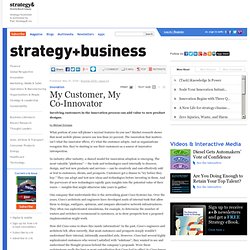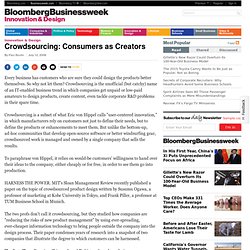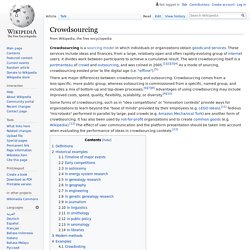

My Customer, My Co-Innovator. What portion of your cell phone’s myriad features do you use?

Market research shows that most mobile phone owners use less than 20 percent. The innovation that matters isn’t what the innovator offers; it’s what the customer adopts. And as organizations recognize this, they’re starting to use their customers as a source of innovative introspection. In industry after industry, a shared model for innovation adoption is emerging. The most valuable “platforms” — the tools and technologies used internally to discover, design, and test new products and services — can be creatively and cost-effectively sold or lent to customers, clients, and prospects. eHow. Crowdsourcing: Consumers as Creators. Every business has customers who are sure they could design the products better themselves.

So why not let them? Crowdsourcing is the unofficial (but catchy) name of an IT-enabled business trend in which companies get unpaid or low-paid amateurs to design products, create content, even tackle corporate R&D problems in their spare time. Crowdsourcing is a subset of what Eric von Hippel calls "user-centered innovation," in which manufacturers rely on customers not just to define their needs, but to define the products or enhancements to meet them. Crowdsourcing. Crowdsourcing is a sourcing model in which individuals or organizations obtain goods and services.

These services include ideas and finances, from a large, relatively open and often rapidly-evolving group of internet users; it divides work between participants to achieve a cumulative result. The word crowdsourcing itself is a portmanteau of crowd and outsourcing, and was coined in 2005.[1][2][3][4] As a mode of sourcing, crowdsourcing existed prior to the digital age (i.e. "offline").[5] There are major differences between crowdsourcing and outsourcing. Crowdsourcing comes from a less-specific, more public group, whereas outsourcing is commissioned from a specific, named group, and includes a mix of bottom-up and top-down processes.[6][7][8] Advantages of using crowdsourcing may include improved costs, speed, quality, flexibility, scalability, or diversity.[9][10]